1825 A ‘cornerstone of cultural strength’
This Place Is Who We Are: Stories of Indigenous Leadership, Resilience,
and Connection to Homelands
by Katherine Palmer Gordon
with a foreword by Dallas Smith
Madeira Park: Harbour Publishing, 2023
$39.95 / 9781990776137
Reviewed by Mary Ann Moore
*
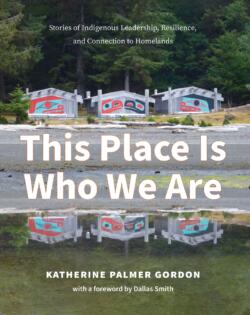 “The central north coast of what settlers refer to as British Columbia in Canada, [is] a vast region which spans the homelands of more than two dozen First Nations,” Katherine Palmer Gordon writes in This Place is Who We Are. A writer of eight non-fiction books, who also works in Indigenous-governmental relations, Palmer Gordon set out to speak to a group of Indigenous individuals “about how people, place and wellbeing are linked.”
“The central north coast of what settlers refer to as British Columbia in Canada, [is] a vast region which spans the homelands of more than two dozen First Nations,” Katherine Palmer Gordon writes in This Place is Who We Are. A writer of eight non-fiction books, who also works in Indigenous-governmental relations, Palmer Gordon set out to speak to a group of Indigenous individuals “about how people, place and wellbeing are linked.”
The people she spoke to reflected on the theme of connection to the places they are from. They also talked about the things they have in common with other Indigenous people. It is those threads that weave themselves “through the fabric of every story” in This Place is Who We Are. Most of the people interviewed for the ten chapters in the book said, “they are not defined by colonization and its legacy.” (European settlers began arriving in the 1600s.) Palmer Gordon says: “People also spoke about mother tongue fluency as a cornerstone of cultural strength.”
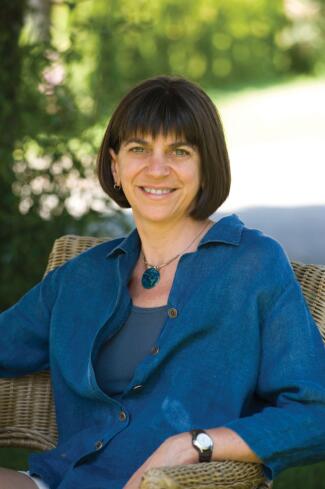
Original place names are cited in the book and, as Palmer Gordon points out, Indigenous people are engaged in reclaiming their languages. There is some re-establishing of “correct original orthographies . . . ” For example, although it has been common to write Heiltsuk, it appears as Haíɫzaqv in the book. A section entitled “Frequently used terms” includes the term “hereditary Chief” which Palmer Gordon describes as “in itself an impoverished English rendering of what is in reality a far more complex, sophisticated, and generous system of inherited or transmitted responsibilities for the wellbeing of both people and places. That can best be understood by reading what people have to say about the role in these stories, explained in their terms rather than mine.”
The foreword, “We Have Always Been Here,” is by Dallas Smith, a citizen of the Tlowitsis Nation, connected to the homelands of Kwakwala-speaking peoples. He is the current chair of Coast Funds, an organization that worked with private donors to raise money “for a new conservation fund in the names of First Nations with territories spanning the region.” Sixty million dollars was matched with contributions from the governments of British Columbia and Canada “to invest in sustainable economic development” for the First Nations. Coast funds covered a portion of the cost of publishing This Place Is Who We Are and all royalties will be donated to the Coast Conservation Environmental Endowment Fund for use by the First Nations with whom Coast Funds works.
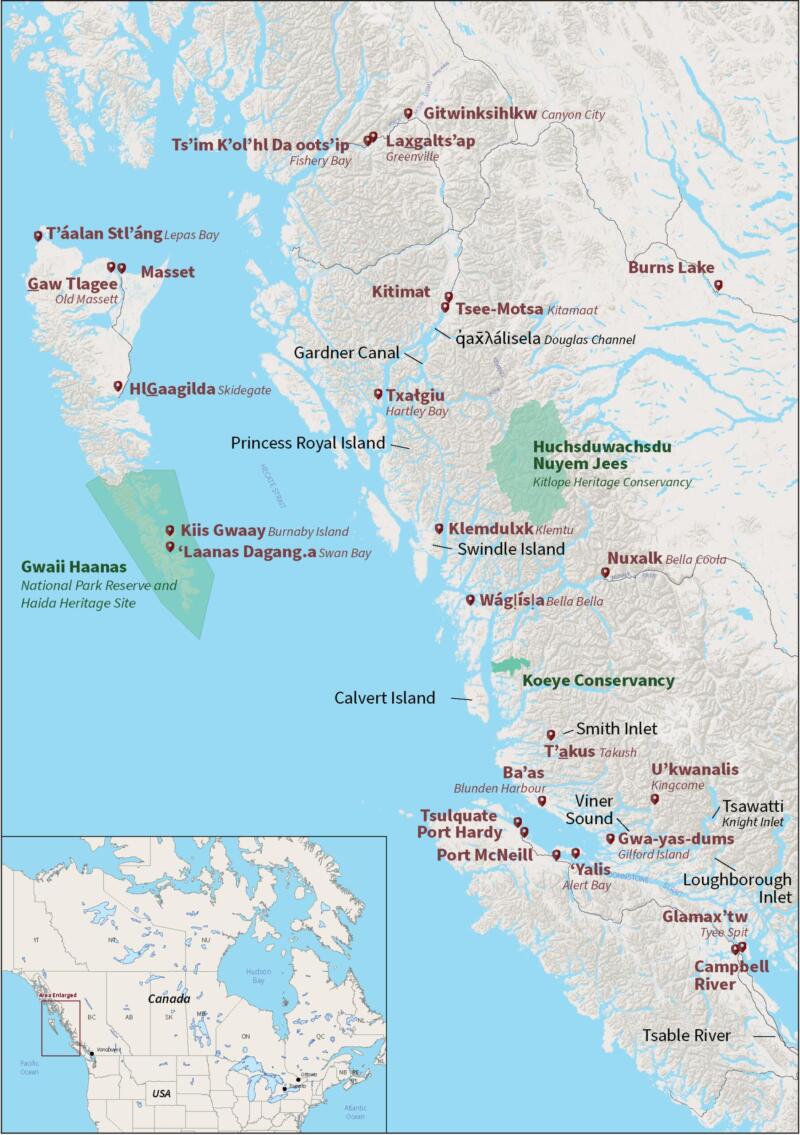
Chapter One is entitled “Stl’mstaliwa – The Whole Human Experience” in which cultural teacher Snxakila (Clyde Tallio) defines the term stl’mstaliwa as having “the full human experience: to be physically, emotionally, intellectually and spiritually balanced. Snxakila is a citizen of the Nuxalk Nation and stl’mstaliwa is a “foundational phrase” in his It7Nuxalkmc lexicon. The contemporary home of the Nuxalk Nation is shown on the map included in the book, where the Nuxalk (Bella Coola) River “empties into the North Bentinck Arm of Burke Channel.” Rather than heading off to university, Snxakila followed a traditional training course in the It7Nuxalkmc language with a group of Elders. Nuxalkmc fisheries biologist Ts’xwiixw (Megan Moody) says of Snxakila, who is in his mid-thirties: “Some say that he is an Elder in a young man’s body. He has the rare ability to fluently speak our language and understand and interpret Nuxalk culture and history while also having the ability to carry out ceremonial practices and share his learnings with the community. Most importantly, he is an amazing spirit who has a great love for Nuxalkmc.”
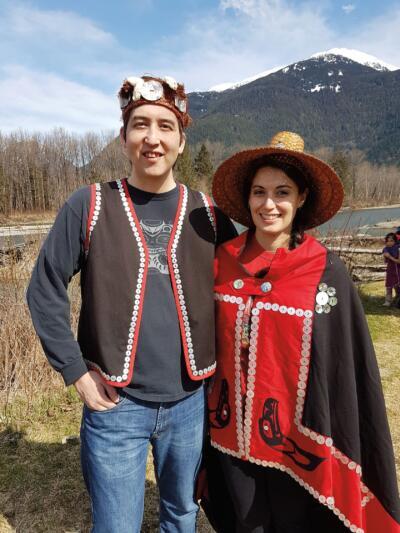
In a chapter entitled “The Sacred Connection,” Paddy Walkus, former Gwa’sala-‘Nakwaxda’xw Chief Councillor is featured. He was born in the tiny Gwa’sala village of T’akus. When he was ten, in 1960, the Department of Indian Affairs (DIA) relocated the villages of T’akus as well as nearby Ba’as, home to the ‘Nakwaxda’xw, to the Tsulquate Indian reserve near Port Hardy on Vancouver Island. The DIA cut off services to both villages and provided enticing descriptions of good housing, running water, school and employment for everyone. In fact, only three houses had been partially built for one hundred people. “We completely lost our way of life,” says Paddy Walkus. “At one point it was brutally predicted that by the early 2000s there would be no Gwa’sala or ‘Nakwaxda’xw people left alive,” Palmer Gordon writes. Paddy Walkus stepped down as Chief Councillor in January 2022. He says: “I cannot emphasize enough how important the voices of the old people have been and our hereditary leaders like Thomas.” (The reference was to ‘Nakwaxda’xw hereditary Chief Hitamas, Thomas Henderson.)
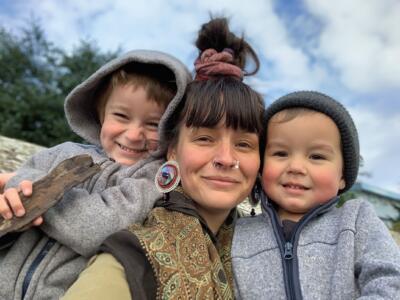
“Haíɫzaqv Unfettered” is a chapter about the community of Wágḷísḷa (Bella Bella) where the Haíɫzaqv people have lived for at least fourteen thousand years. Haíɫzaqv citizens devoted many years to protest campaigns and eventually defeated Enbridge Inc.’s proposed Northern Gateway pipeline. I had the honour of being invited to Wágḷísḷa some years ago by Hílístis (Pauline Waterfall) who is featured in the chapter. She is “an artist, author, and educator who has dedicated her adult life to working not only for her community but for access to education for all Indigenous people. Pauline has, in her own way, shown the younger woman the true meaning and importance of being ‘Haíɫzaqv unfettered’.” The ”younger woman” referred to is Cúagilákv (Jess H̓áust̓I), the executive director of the Qqs Projects Society, a Haíɫzaqv charitable non-profit organization supporting youth and families. As well as being an active community volunteer, and mother to two young boys, Jess is endeavouring to immerse them in their language and cultural traditions.
In “Our Homelands Build Us Up and Make Us Strong,” key Xaayda (Haida) community members describe their Rediscovery camps for healing and empowering youth “by reconnecting them to their lands and waters.” Xaaydaga Gwaay.yaay/Xaayda Gwaay (Haida Gwaii) is an archipelago made up of more than two hundred islands separated from the northwest coast of British Columbia by the Hecate Strait. The cover photo is of ‘Laanas Daganag,a (Swan Bay) Rediscovery Camp which began operating in 2003 on Kiis Gwaay (Burnaby Island) in Gwaii Haanas, a five-thousand-square-kilometre protected area in the southern part of the archipelago. “Language is a key part of the Rediscovery experience for participants,” Palmer Gordon writes.
Gwaliga Hart, who has studied cultural anthropology and archaeology at the University of British Columbia and Xaad kil, the northern dialect of the Xaada language, says: “Everything is in the language: humour, philosophy, all the intricacies and interconnectedness of our art and how that is woven into our everyday lives. It is unique, just as we are. It is the most wonderfully woven fabric of the most incredible blanket of our identity and our existence.”
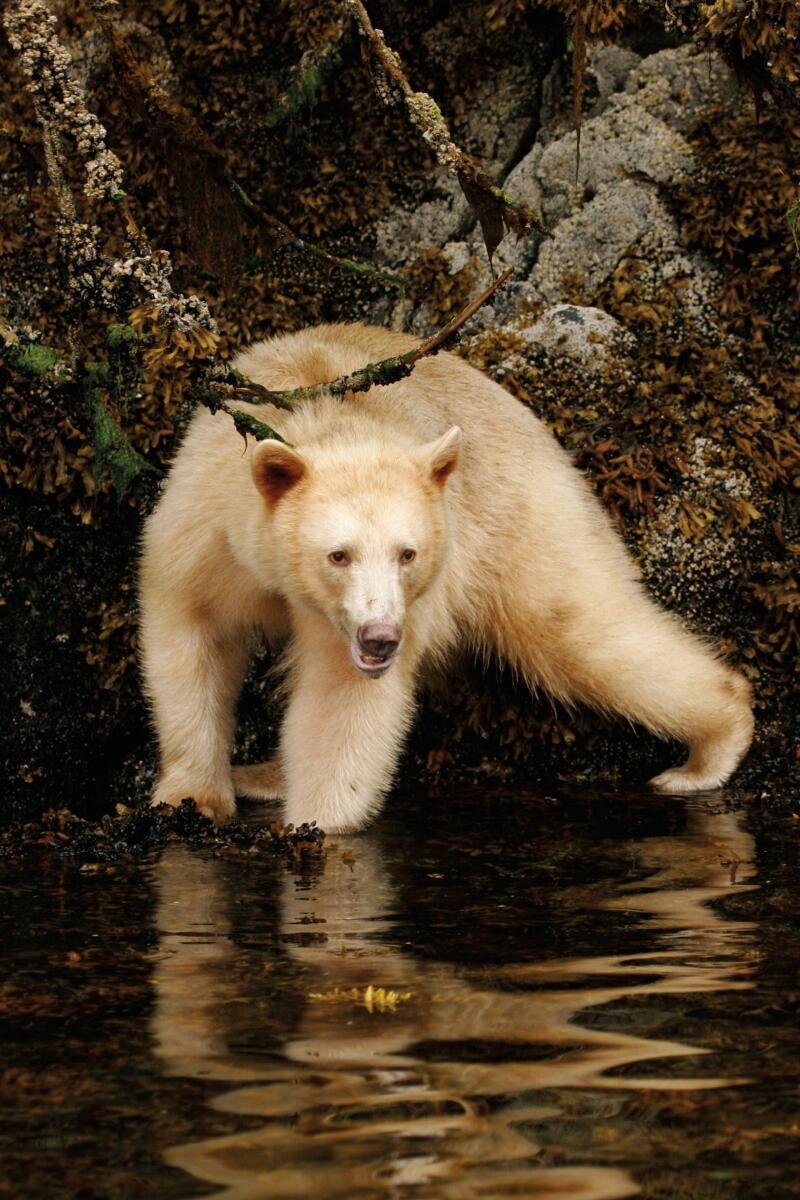
Chapter Eight, “A Voice for the Bears,” describes a young woman, Hbuk’vas’tam-hyu (Mercedes Robinson Neasloss), ten years old at the time who spoke for her generation and “the next generations to come” in front of the National Energy Board’s Joint Review panel for Enbridge Inc’s proposed Northern Gateway Pipeline. Her Kitasoo/Xai’xais community members were gathered to share their views in Klemdulxk, commonly called Klemtu. The people of Klemtu, on the east side of Swindle Island, five hundred kilometres north of Vancouver, “have a particularly close connection, both contemporary and ancient, to the bear that roams their territory,” Palmer Gordon writes. In the early 2000s, a “basic” bear-viewing operation began which later became Spirit Bear Lodge in 2006. The lodge sponsors Súa, a Kitasoo/Xai’xais youth cultural program. The Kitasoo/Xai’xais “also established the Spirit Bear Research Foundation in 2011, in collaboration with wildlife biologists and bear researchers. As Mercedes says, now entering her third decade of life: “The biggest lessons in my life so far have been to always respect the territory and to protect the land and the bears so that future generations will always have the opportunity to enjoy what we have. I can’t think of anything more important for [the] children to learn than those same lessons.”
This Place is Who We Are is a gorgeous book in every way: visually with its glossy pages and vibrant, full-colour photos; in the meticulous care Katherine Palmer Gordon took in her endeavour to share the voices of First Nations communities; and in the stories told that celebrate resilience, healing, cultural strength, and love of land, identity, ancestors and each other.
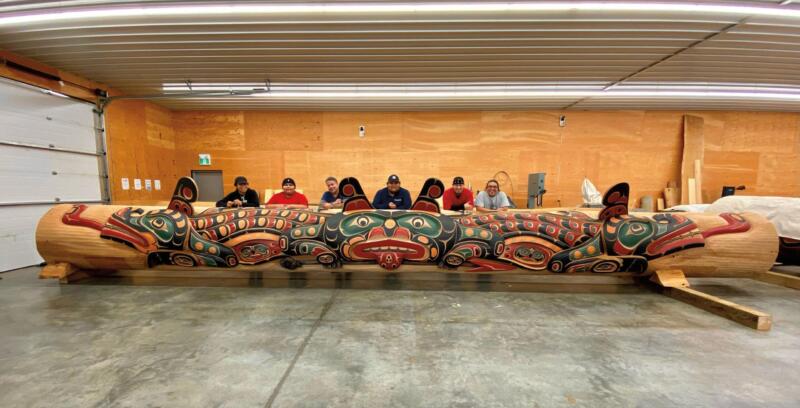
*
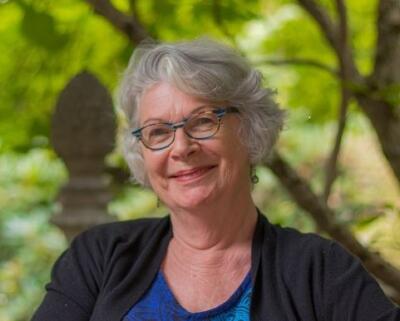 Mary Ann Moore is a poet, writer and writing mentor who lives on the unceded lands of the Snuneymuxw First Nation in Nanaimo. Her full-length book of poetry is Fishing for Mermaids (Leaf Press, 2014) and she has a new chapbook of poems called Mending (house of appleton). Moore leads writing circles and has two writing resources: Writing to Map Your Spiritual Journey (International Association for Journal Writing) and Writing Home: A Whole Life Practice (Flying Mermaids Studio). She writes a blog here. Editor’s note: Mary Ann Moore has also reviewed books by Donna McCart Sharkey & Arleen Paré, Michelle Poirier Brown, and Celia Haig-Brown, Garry Gottfriedson, Randy Fred, & the KIRS Survivors for The British Columbia Review.
Mary Ann Moore is a poet, writer and writing mentor who lives on the unceded lands of the Snuneymuxw First Nation in Nanaimo. Her full-length book of poetry is Fishing for Mermaids (Leaf Press, 2014) and she has a new chapbook of poems called Mending (house of appleton). Moore leads writing circles and has two writing resources: Writing to Map Your Spiritual Journey (International Association for Journal Writing) and Writing Home: A Whole Life Practice (Flying Mermaids Studio). She writes a blog here. Editor’s note: Mary Ann Moore has also reviewed books by Donna McCart Sharkey & Arleen Paré, Michelle Poirier Brown, and Celia Haig-Brown, Garry Gottfriedson, Randy Fred, & the KIRS Survivors for The British Columbia Review.
*
The British Columbia Review
Interim Editors, 2023-24: Trevor Marc Hughes (non-fiction), Brett Josef Grubisic (fiction)
Publisher: Richard Mackie
Formerly The Ormsby Review, The British Columbia Review is an on-line book review and journal service for BC writers and readers. The Advisory Board now consists of Jean Barman, Wade Davis, Robin Fisher, Barry Gough, Hugh Johnston, Kathy Mezei, Patricia Roy, Maria Tippett, and Graeme Wynn. Provincial Government Patron (since September 2018): Creative BC. Honorary Patron: Yosef Wosk. Scholarly Patron: SFU Graduate Liberal Studies. The British Columbia Review was founded in 2016 by Richard Mackie and Alan Twigg.
“Only connect.” – E.M. Forster
8 comments on “1825 A ‘cornerstone of cultural strength’”